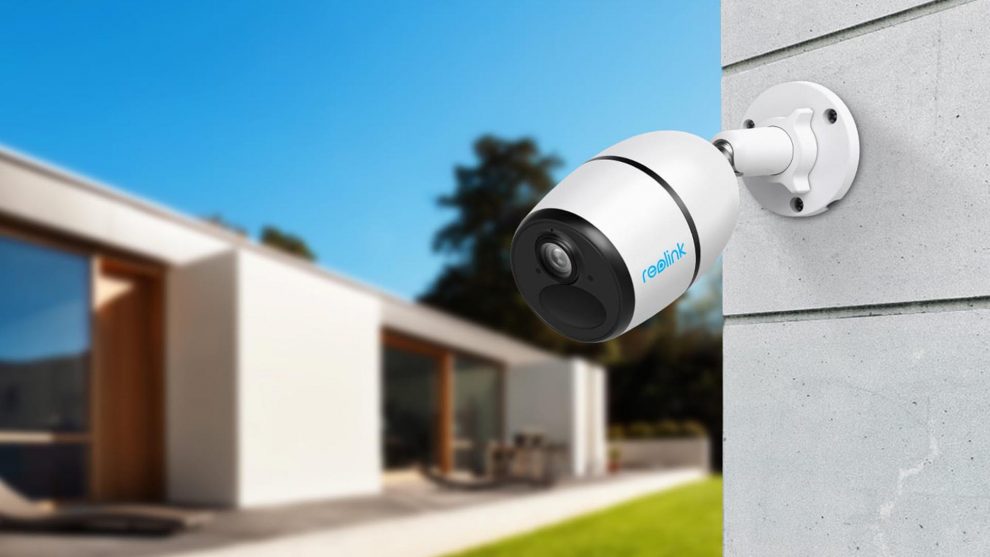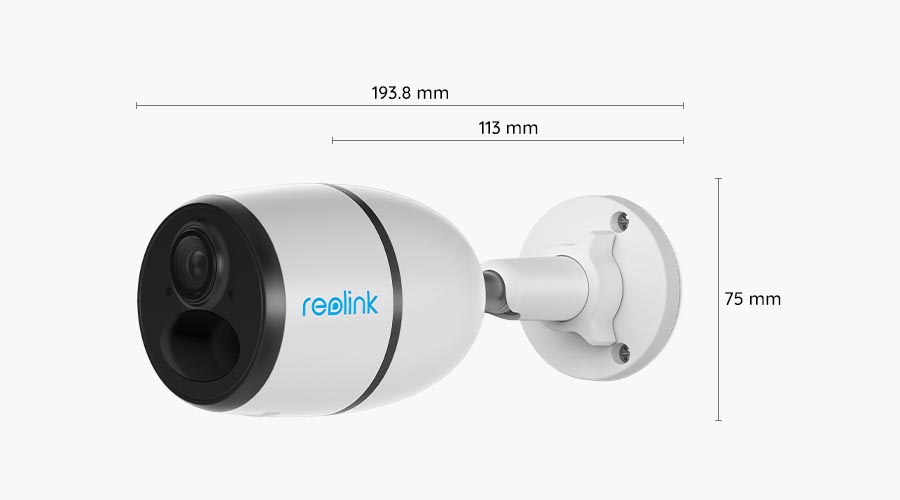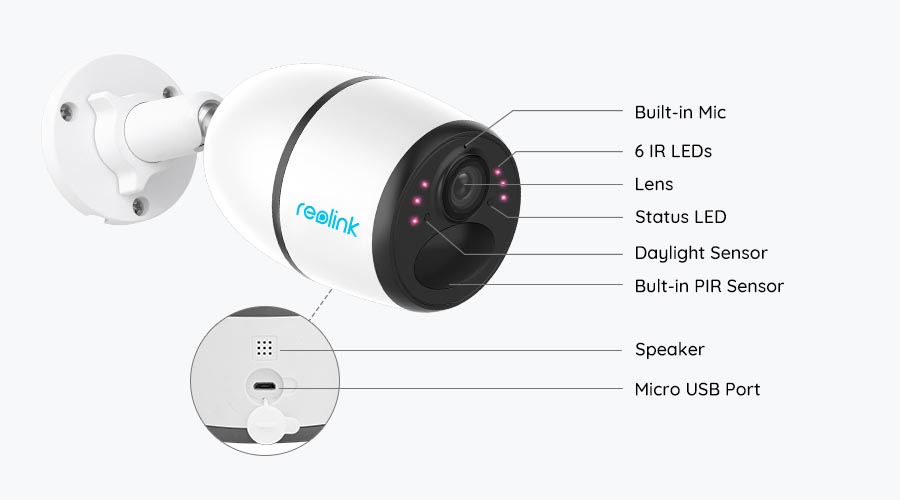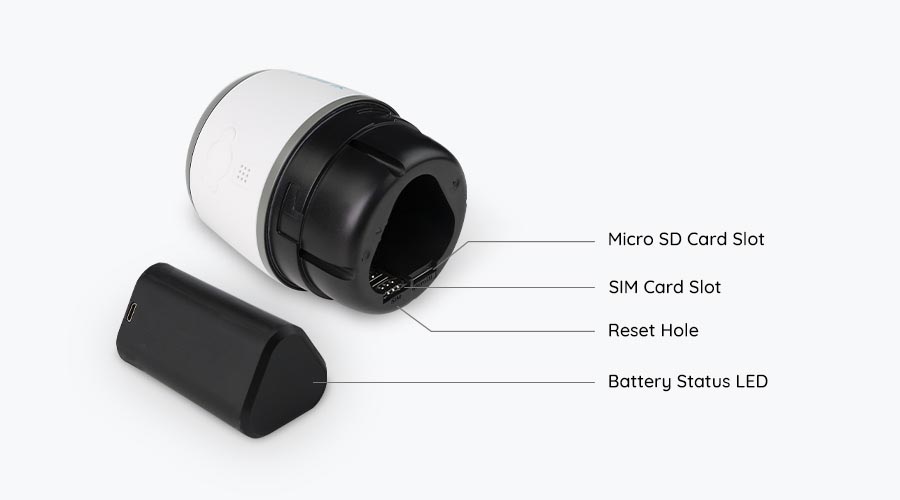PROS
- Practical and simple to use
- High resolution
- Long autonomy
- Low data consumption
CONS
- High price
- Micro-USB connector instead of USB-C
- No information provided during firmware updates

January 1st, 2022 – Safety in the van is important. Not only that during the stay inside the vehicle, but also that of the vehicle itself when we go out to go skiing, to the museum, to the historic center or to the beach. Those are the moments in which you risk the most: thieves know that the tourist who gets off a motorhome will return to the worst after a few tens of minutes, but often a few hours later. And they prepare to strike.
There are no inviolable anti-theft devices, but since it is good and right to make life difficult for the criminal, we can take a step further: adopt a surveillance camera that warns us promptly in the event of an intrusion. In a van, however, it is not as easy as at home.
Let’s review the basics
When we have 220 volts current and a fixed Internet connection, as in the case of ADSL or optical fiber, everything is simple. The offers on the market are many and range from a single video camera to a complete video surveillance system with a control unit to record video streams from multiple devices. The cheapest solution (a few tens of euros) consists in the Wi-Fi connection of a video camera connected to the power supply.
When you get into a recreational vehicle, the basic infrastructure tends to be missing. The most technological may have equipped themselves, but we must not do it without knowledge of the facts: keeping a router connected to the cellular network and a video camera constantly active involves electricity consumption that we must be aware of, to avoid drawing too much energy from the service battery.
However, a much simpler solution comes to our aid: that of a video camera already equipped with a 4G cellular connection and powered by a rechargeable battery. This avoids laying cables and the need to rely on an existing Wi-Fi network – ultimately just fix the camera somewhere and it just works. The only prerequisite is to have a data-enabled mobile SIM. No worries about the amount of giga (GB): the data is used in discrete quantities only when viewing the videos remotely and therefore in the end we are talking about a few megabytes (1 GB = 1,024 MB).
From the garden to the van
In this sector, there are not many products available, given that the need is really specific. The few that exist are born with the idea of positioning them in parks and gardens, where bringing electricity and Wi-Fi is often not easy. In our case, however, we can perfectly exploit its characteristics to protect the vehicle.
The latest addition to our Falkor is a video camera from Reolink, a manufacturer specializing in video surveillance solutions that already has 4 products in its catalog designed to work independently. Two have fixed framing and two can instead move the optics on the two axes to change the controlled area. It is true that our Falkor is a “palace” for us, but realistically speaking, a fixed-frame video camera is more than enough to keep the 8 square meters of our home under control. So, we opted for the Reolink Go Plus model.
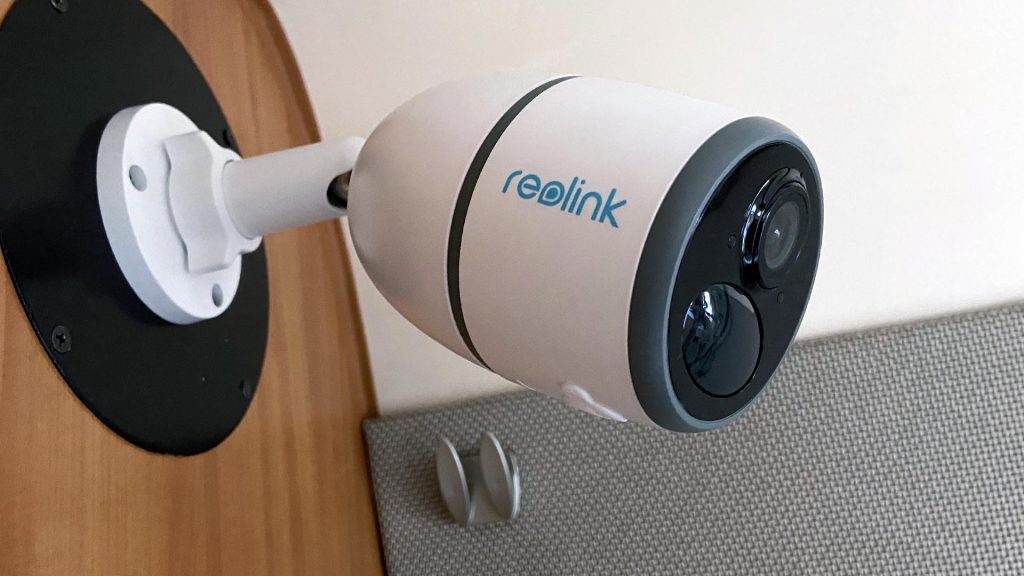
Compared to the “basic” Reolink Go version, it is essentially distinguished by a higher resolution (2,560 by 1,440 pixels against 1,920 by 1,080, in both cases at 15 frames per second) and by a system capable of distinguishing the movement of vehicles with respect to that of people and animals. On the other hand, the angle covered by its optics is 95 degrees against 110. More than enough, however, for the interior of a recreational vehicle.
All that you need
The package includes the video camera, the support to be fixed to the wall, the micro-USB cable for charging the battery, a silicone cover with a “camouflage” effect, screws and dowels, a strap to possibly fix the product to a trunk tree, a template, a sticker indicating that the area is under video surveillance and a quick guide. A power supply is missing, and we would have appreciated the presence of a USB-C connector, but everything you need is there.
The rounded shape of the camera does not allow it to be simply placed on a surface, but it must be fixed on the supplied stand. On our Falkor we took advantage of the predisposition for the cellular loudspeakers(which we do not have) by creating a round metal plate on which to screw the Reolink support. The installation phase is however the one in which the arrangement of the furnishings and personal imagination make the difference, and everyone, on their own vehicle, will have to find the most suitable solution.
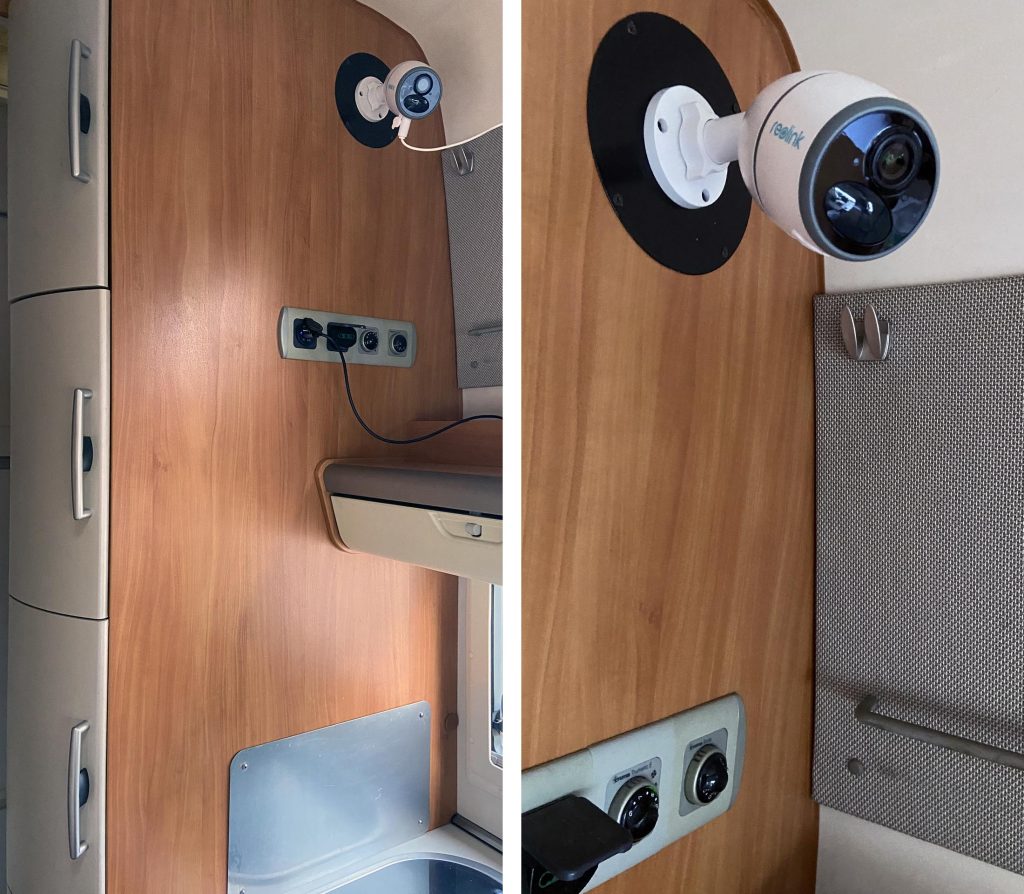
The SIM that we will use in the camera must be activated in advance (using any smartphone) and the initial PIN it must be eventually excluded. Next to the SIM slot there is also the one that allows you to accommodate a memory card in microSD format up to 128 gigabytes. As an alternative to the memory card, in some countries it is possible to use a cloud service proposed by Reolink, but for the moment it is not available in Europe. For use on a recreational vehicle this is not a big problem: on the contrary, it avoids having fixed expenses other than those of the SIM.
A precious complement
So let’s get to the reasons why a product like this is worth installing. When on vacation, the vehicle is hardly left too far away. Usually, you park it to go to a restaurant, to spend a few hours on the beach or to ski, for a short excursion or to visit an exhibition or museum. In this case, the video camera becomes a precious complement to the more traditional anti-theft devices, which should never be missing. We all know that if a thief targets our motorhome we will hardly be able to dissuade him, but the more tools available we have, the better the chances of saving our assets.
In this specific case, when the camera detects an abnormal movement inside the vehicle, it sends an immediate warning message to our phone, allowing us to connect to the device and watch what is happening in real time. In the event of a break-in, we will be able to trigger a siren (whose sound is also customizable) or talk to the intruder. Sometimes it is enough to make it clear that everything is being recorded to make the villain give up. In any case, we can simultaneously warn the police or return quickly to our vehicle.
The video camera is also useful in other, less dramatic cases. For example, if we have a pet that we are forced to leave in the vehicle for a short time (in any case never under the sun!), we can check from time to time that everything is okay.
Let time take its course
We are satisfied with the operation. The only problem we recorded was during the first installation phase: when you insert the SIM and start the camera for the first time, the system checks for any firmware updates and, if so, proceeds with the download and installation. In the version we tested, which was a pre-production model, there was no report of this process and so we contacted customer service to understand why we were “stuck”: the doubt was that the camera was not working. In reality, it was enough to let time run its course.
The battery life was more than satisfactory: before writing this test we basically recorded two life cycles of about 3 weeks each. Obviously, most of the time the device is on standby, so the energy consumption is limited. The 3 weeks we experienced are enough for most of the holidays and a long enough time that the need to recharge is not a problem or discomfort.
Solar panel: ok for the garden, less in the van
Reolink, which proposes the Go Plus as the perfect solution for gardens or areas where there is no electricity and Wi-Fi (by the way, this product cannot be used with networks of this type, nor can it share its 3G/4G connection), has a catalog also a small solar panel (sold for €30), which positioned correctly and fixed with a support similar to that of the camera allows you to maintain a constant power supply, without the need for refills. We liked the idea, but to be honest it didn’t seem ideal for a recreational vehicle: running cables in a fixed form for such an object is not worth it and then van usually already have their solar panels.
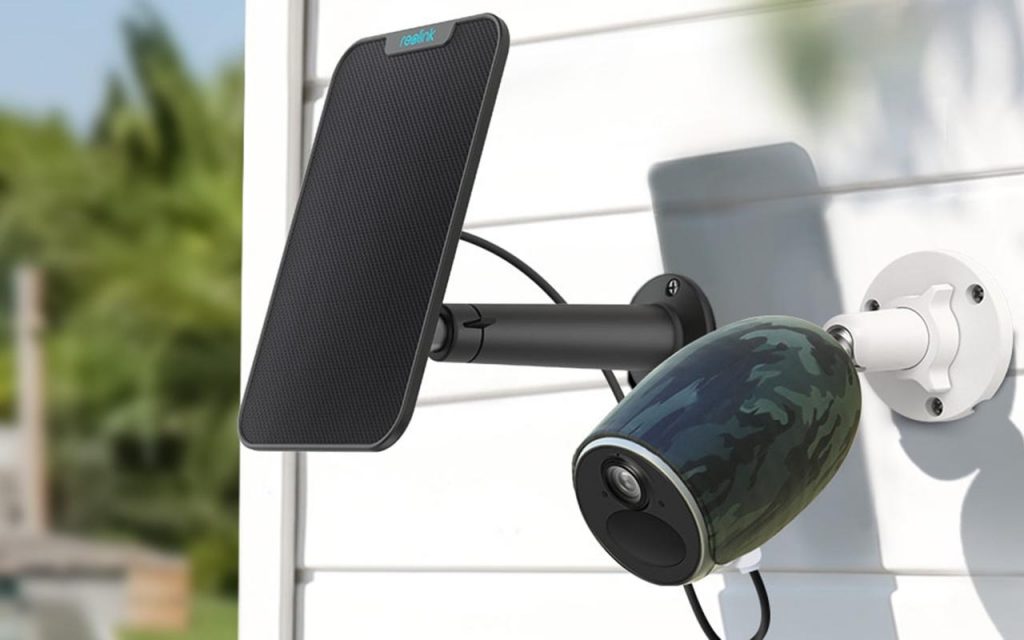
We tried to use it internally, but the need to reorient it towards the sun when moving the vehicle (and therefore to find a new position for it each time) made us give up quickly. There would actually be the possibility of constantly keeping the camera powered via the micro-USB port, but Reolink – while confirming this possibility – does not recommend doing so, probably to preserve battery life.
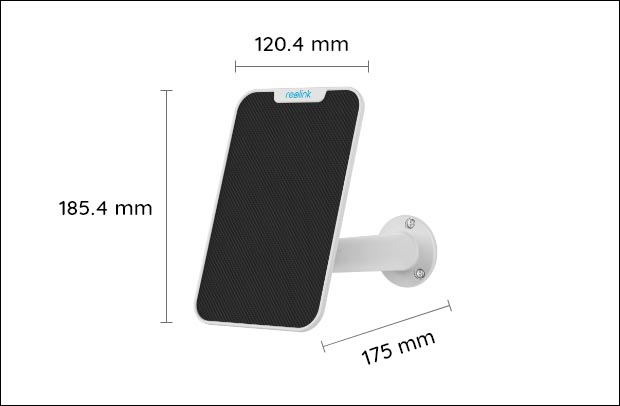
Versatile app
On the other hand, the various functions that can be adjusted via the app are very interesting. The Reolink Go Plus, for example, can be managed with a schedule to activate or deactivate the camera at specific times. It should be noted that products of this type cannot be kept active while we are inside the vehicle, because the continuous motion detection would activate the notifications, which would become continuous, annoying and – above all – lead to battery exhaustion in a short time. The camera must therefore be activated when you leave the vehicle and reactivated when you return or managed by schedule.
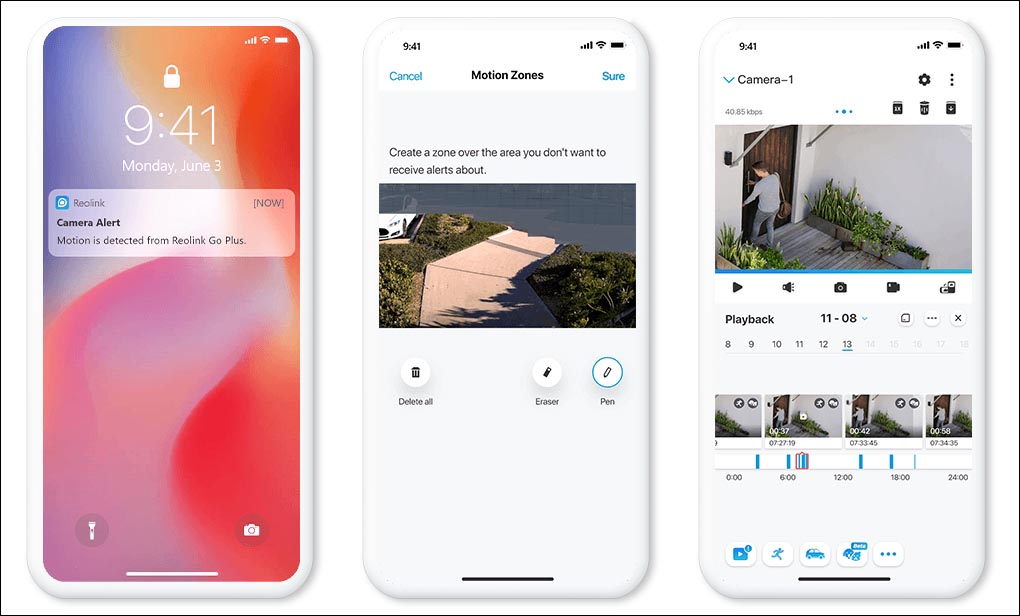
The Reolink Go Plus detects movements both night and day, up to 10 meters. The night vision, enabled by infrared, shows black and white images and the transition from day to night mode is completely automatic. The sensitivity of the PIR sensor can be manually adjusted to reduce any false alarms. In the event of movement, the device activates a push notification on the smartphone, record a video for at least 8 seconds or until the end of the recognized movement, and sends an email to the address we chose during the setting phase. Multiple phones can also be paired with the camera.
Also perfect outside
Given the nature of the Reolink Go Plus there are also functions that are not very useful on a van, but if you decide to make a mixed use of the device, perhaps removing it from the vehicle when you leave it in storage, they can be handy. For example, it is possible to define areas of the frame in which movement is not detected, such as the road that passes right in front of the gate. The camera is naturally resistant to water and dust, being IP65 certified. Multiple cameras (up to 16) can be connected to the same app, even with a mix of 4G and Wi-Fi devices to create complete video surveillance systems.
A more creative function is that of “time lapse”. Videos captured with this technique allow you to reproduce in a few seconds scenes that lasted hours or days. The camera is preset to best capture sunrises, sunsets, moving clouds, blooms, or constractions, but you can also manually set the parameters.

All recordings, whether made by activating the motion sensor or shooting in time lapse, after recording on the microSD card can be viewed remotely or downloaded to your phone. In general, the data to be kept under control is that of the data consumed. As a parameter, viewing images in Full HD format (1,920 by 1,080) will require approximately 2 gigabytes of data for each hour of viewing. In short, nothing that a plan for a handful of euros a month cannot manage.
Compatible with smart homes
Finally, the Reolink Go Plus can be integrated into home automation systems compatible with Google Home or Amazon Alexa. However, the insertion process requires you to have a Chromecast device in the first case or an Echo in the second. Honestly, we have not tested these functions: our “home” is so small that we are happy to avoid the “smart home”!

Ultimately, we liked the product. Perhaps its footprint could be a little smaller, but once the right position is found, it is certainly not a device with annoying dimensions. The important thing is that he does his job well, and it does it. The purchase cost is not as low as that of a Wi-Fi video camera, but still more limited than alternative solutions proposed by the competition. The suggested retail price is €280, but at the time of writing (December 31, 2021) the manufacturer is offering the Reolink Go Plus for €252. Those who want to save a little more can choose the Reolink Go for €207 (instead of €230), at the price of a slightly lower resolution.
©2021 seimetri.it – If you want to leave a comment on this article, you can do it on our Facebook page











